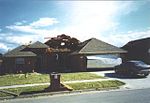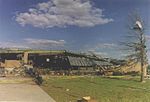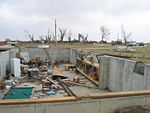en.wikipedia.org
Historically, the Beaufort wind force scale
provides an empirical description of wind speed based on observed sea
conditions. Originally it was a 13-level scale, but during the 1940s,
the scale was expanded to 17 levels.[17]
There are general terms that differentiate winds of different average
speeds such as a breeze, a gale, a storm, tornado, or a hurricane.
Within the Beaufort scale, gale-force winds lie between 28 knots
(52 km/h) and 55 knots (102 km/h) with preceding adjectives such as
moderate, fresh, strong, and whole used to differentiate the wind's
strength within the gale category.[18]
A storm has winds of 56 knots (104 km/h) to 63 knots (117 km/h).[19]
The terminology for tropical cyclones differs from one region to
another globally. Most ocean basins use the average wind speed to
determine the tropical cyclone's category. Below is a summary of the
classifications used by Regional Specialized Meteorological Centers worldwide:| [hide]General wind classifications | Tropical cyclone classifications (all winds are 10-minute averages) | |||||||
|---|---|---|---|---|---|---|---|---|
| Beaufort scale[17] | 10-minute sustained winds (knots) | General term[20] | N Indian Ocean IMD |
SW Indian Ocean MF |
Australian region South Pacific BoM, BMKG, FMS, MSNZ |
NW Pacific JMA |
NW Pacific JTWC |
NE Pacific & N Atlantic NHC & CPHC |
| 0 | <1 | Calm | Low Pressure Area | Tropical disturbance | Tropical low Tropical Depression |
Tropical depression | Tropical depression | Tropical depression |
| 1 | 1–3 | Light air | ||||||
| 2 | 4–6 | Light breeze | ||||||
| 3 | 7–10 | Gentle breeze | ||||||
| 4 | 11–16 | Moderate breeze | ||||||
| 5 | 17–21 | Fresh breeze | Depression | |||||
| 6 | 22–27 | Strong breeze | ||||||
| 7 | 28–29 | Moderate gale | Deep depression | Tropical depression | ||||
| 30–33 | ||||||||
| 8 | 34–40 | Fresh gale | Cyclonic storm | Moderate tropical storm | Tropical cyclone (1) | Tropical storm | Tropical storm | Tropical storm |
| 9 | 41–47 | Strong gale | ||||||
| 10 | 48–55 | Whole gale | Severe cyclonic storm | Severe tropical storm | Tropical cyclone (2) | Severe tropical storm | ||
| 11 | 56–63 | Storm | ||||||
| 12 | 64–72 | Hurricane | Very severe cyclonic storm | Tropical cyclone | Severe tropical cyclone (3) | Typhoon | Typhoon | Hurricane (1) |
| 13 | 73–85 | Hurricane (2) | ||||||
| 14 | 86–89 | Severe tropical cyclone (4) | Major hurricane (3) | |||||
| 15 | 90–99 | Intense tropical cyclone | ||||||
| 16 | 100–106 | Major hurricane (4) | ||||||
| 17 | 107–114 | Severe tropical cyclone (5) | ||||||
| 115–119 | Very intense tropical cyclone | Super typhoon | ||||||
| >120 | Super cyclonic storm | Major hurricane (5) | ||||||
Fujita scale
The Enhanced Fujita Scale (EF Scale) rates the strength of tornadoes in the United States based on the damage they cause. Below is that scale.| Scale | Wind speed | Relative frequency | Potential damage | ||
| mph | km/h | ||||
| EF0 | 65–85 | 105–137 | 53.5% | Minor or no damage.
Peels surface off some roofs; some damage to gutters or siding; branches broken off trees; shallow-rooted trees pushed over. Confirmed tornadoes with no reported damage (i.e., those that remain in open fields) are always rated EF0. |
|
| EF1 | 86–110 | 138–178 | 31.6% | Moderate damage. Roofs severely stripped; mobile homes overturned or badly damaged; loss of exterior doors; windows and other glass broken. | |
| EF2 | 111–135 | 179–218 | 10.7% | Considerable damage. Roofs torn off well-constructed houses; foundations of frame homes shifted; mobile homes completely destroyed; large trees snapped or uprooted; light-object missiles generated; cars lifted off ground. | |
| EF3 | 136–165 | 219–266 | 3.4% | Severe damage. Entire stories of well-constructed houses destroyed; severe damage to large buildings such as shopping malls; trains overturned; trees debarked; heavy cars lifted off the ground and thrown; structures with weak foundations are badly damaged. | |
| EF4 | 166–200 | 267–322 | 0.7% | Extreme damage. Well-constructed and whole frame houses completely leveled; cars and other large objects thrown and small missiles generated. | |
| EF5 | >200 | >322 | <0.1% | Total Destruction. Strong-framed, well-built houses leveled off and foundations swept away; steel-reinforced concrete structures are critically damaged; tall buildings collapse or have severe structural deformations. | |







0 Comment:
Post a Comment